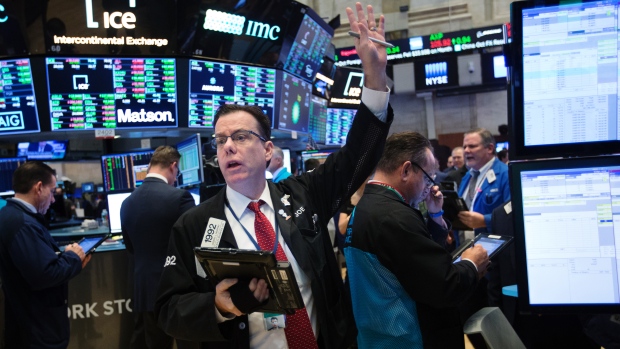Nov 14, 2018
U.S. stocks fall again, TSX barely up
, Bloomberg News

U.S. stocks fell for a fifth straight day as investors remained on edge amid ongoing concerns over trade, political turmoil and economic growth. Crude halted its longest losing streak on record.
The S&P 500 Index slumped to the lowest in two weeks after a key Democrat raised questions about the revamped Nafta deal and selling in Apple Inc. rekindled concern that megacap tech earnings have peaked. An afternoon respite from the selling sparked by U.K. Prime Minister Theresa May clinching a Brexit deal with her cabinet gave way to a tumble into the close. Goldman Sachs’s woes continued, with the bank down 13 per cent in four days to the lowest since November 2016.
In Canada, the S&P/TSX Composite closed Wednesday barely in the green, up 1.34 points to 15,133.12.
Equities were under pressure as concern mounted that global economic growth has peaked as central banks remove monetary stimulus and the U.S. escalates trade disputes with key partners. Tense Brexit negotiations and a charged political atmosphere in America added to concern.
Treasuries rose with gold as investors sought out havens. West Texas crude climbed above US$56 a barrel after plunging for a record 12 straight days. Natural gas surged as unseasonably cold weather threatens the U.S. Northeast. Bitcoin tumbled to the lowest level of the year.
“There’s a lot of different factors that are weighing on risk assets,” said Mark Heppenstall, chief investment officer, Penn Mutual Asset Management. “From individual company concerns, to wildfires in California, to some very odd behavior in the price of oil and natural gas. The other thing is the Fed is probably going to be put to its real first test where the markets may begin to question how wise it is.”
Comments from a key Democrat rekindled concern that the revamped Nafta deal won’t end tensions among North American partners at the same time that negotiations with China remain fraught. Trade has weighed on equity markets since the U.S. began slapping tariffs on goods as a key part of the agenda to revamp deals. Markets got a reprieve from the rout in crude, but questions remain about the sharp downturn in the tech sector and the future of interest rates. Brexit and Italian risks linger, and key reports on the crude market are also imminent.
Focus will turn this evening to Federal Reserve Chairman Jerome Powell, with some observers expecting him to calm worries about the central bank pushing its interest rate-hike cycle too far. That comes after the latest read on China’s economy, where retail sales missed estimates, though industrial production held up.
In Europe, the Stoxx 600 was dragged down by sectors including mining and energy, though good news for autos helped offset the slide. The pound had weakened after inflation undershot estimates, but trimmed the drop as traders wait to see if Theresa May can persuade colleagues to back her Brexit deal. Italy’s 10-year bonds slipped after the government submitted a defiant budget to the European Commission on Tuesday.
These are the main moves in markets:
Stocks
The S&P 500 fell 0.8 per cent at 4:04 p.m. New York time. The Nasdaq 100 lost 0.8 per cent. The Russell 2000 slid 0.8 per cent. The Stoxx Europe 600 Index lost 0.6 per cent. The MSCI Asia Pacific Index dipped 0.2 per cent to the lowest in two weeks. The MSCI Emerging Market Index advanced less than 0.1 per cent, the first advance in a week.
Currencies
The Bloomberg Dollar Spot Index was flat. The euro gained less than 0.1 per cent to US$1.1285. The British pound fell 0.5 per cent to US$1.291. The Japanese yen added 0.1 per cent to 113.65 per dollar.
Bonds
The yield on 10-year Treasuries slid three basis points to 3.11 per cent. The two-year rate slipped three basis points to 2.85 per cent. Germany’s 10-year yield fell less than one basis point to 0.41 per cent. Britain’s 10-year yield dipped two basis points to 1.501 per cent.
Commodities
West Texas Intermediate crude jumped 1 per cent to US$56.26 a barrel, the first advance in almost three weeks and the largest surge in six weeks. Gold futures rose 0.8 per cent to US$1,211.40 an ounce. Natural gas futures surged 17 per cent.




